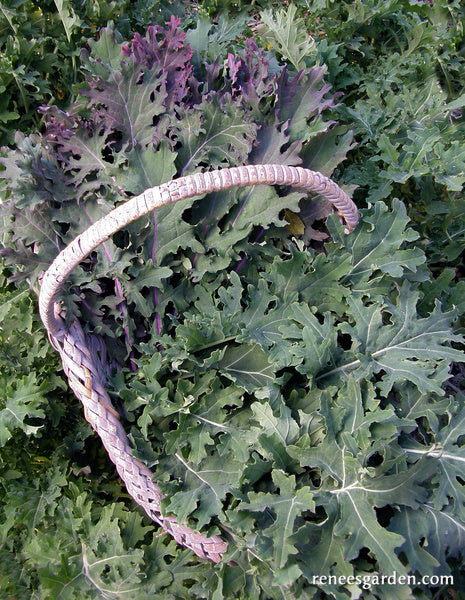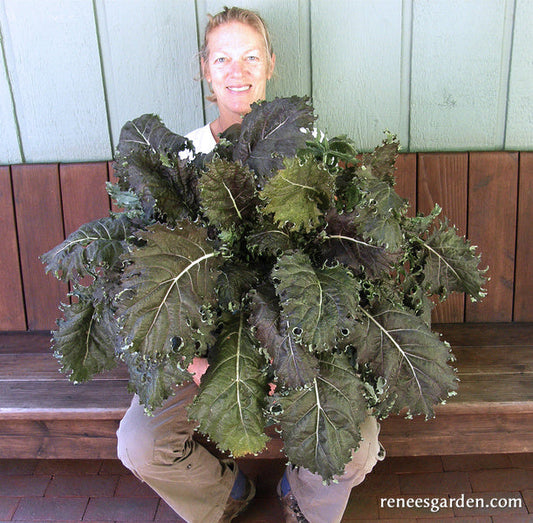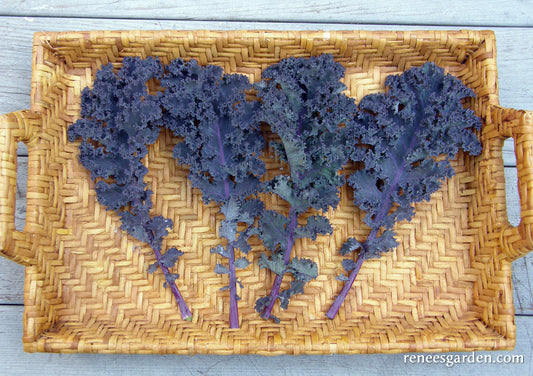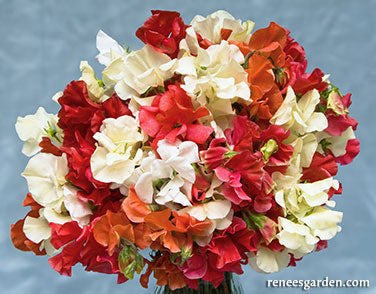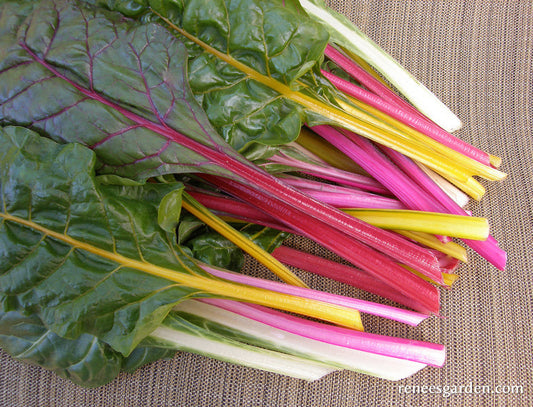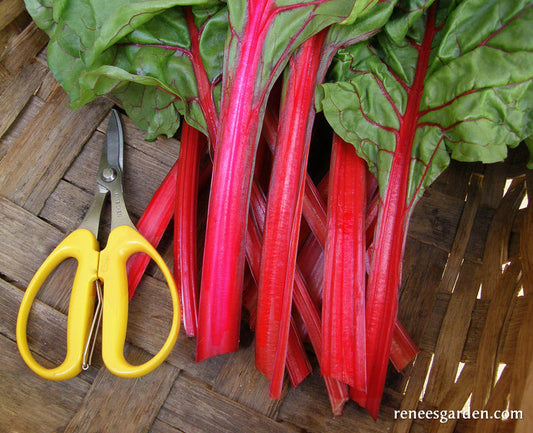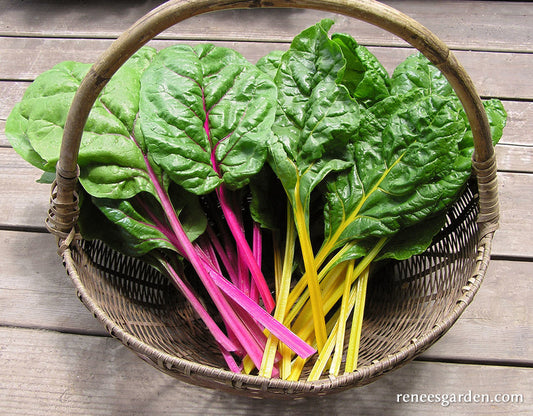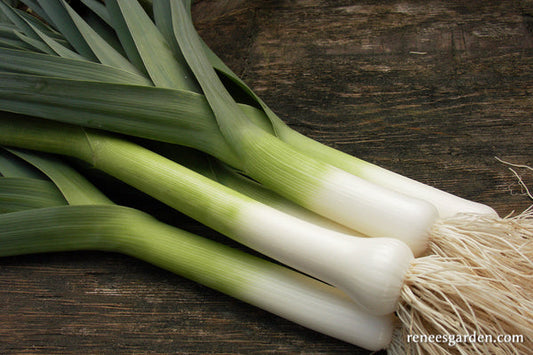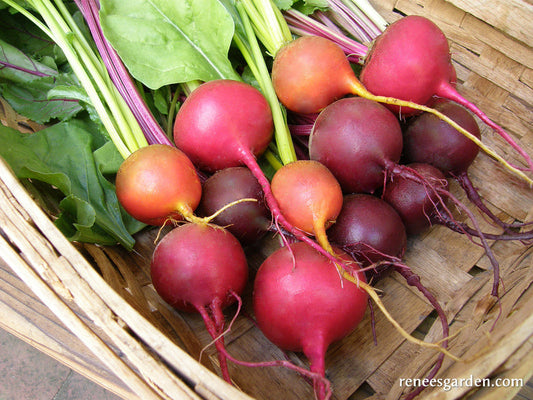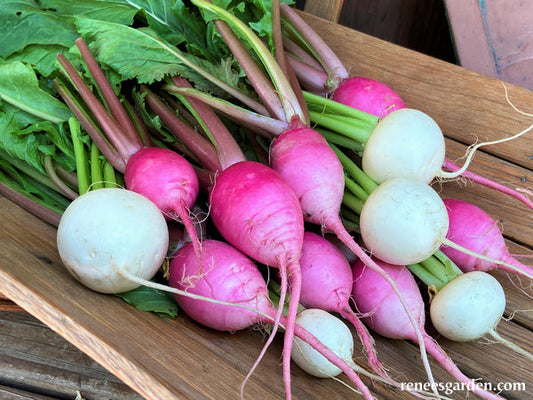Seeds For Fall Gardens
Seeds For Fall Gardens
In cold winter areas: plant mid-summer. In mild winter areas: plant mid-summer/early fall.
-
Green & Red Romaines Renee's Caesar Duo
START SEEDS OUTDOORS
In cool early spring weather, start seeds in finely worked soil in full sun. Sow 1/4 inch deep and 1 inch apart in rows 6 to 8 inches apart and cover lightly. Tend carefully and keep evenly moist. Gradually thin seedlings out, allowing remaining plants to stand 10 to 12 inches apart so heads have room to mature. For a constant supply, make several sowings a few weeks apart until summer weather turns hot. Plant again in late summer for fall harvest.
GROWING NOTES
Lettuce thrives in cool conditions with consistent moisture. Weed, water and thin carefully for best quality heads. If birds are attracted to the young seedlings, cover them with floating row covers or netting.
HARVEST AND USE
Savor young thinnings in your first spring salads. Then harvest plants by cutting mature heads when they feel firm and well-filled out. Pull and discard or compost over-mature plants if they begin to elongate (“bolt”) in hot weather as they are bitter at this stage. These crispy colorful romaines are perfect for centerpiece Caesar salads that rival the finest restaurant. Use top quality ingredients to make dressing, or you can find my favorite recipe on our website: reneesgarden.com/recipes
Regular price $3.39Sale price $3.39Unit price / per -
Heirloom Russian Kale Wild Garden Frills
TO START DIRECTLY IN THE GARDEN
As soon as ground can be worked in spring, prepare a well-drained, fertile garden bed in full sun. Sow seeds 2 inches apart in rows 12 to 18 inches apart. Cover 1/2 inch deep and keep soil evenly moist to ensure good germination. Sow again in late summer for another cold-hardy crop.
TO START INDOORS
Sow seeds in a container of seed starting mix 2 inches apart and cover 1/2 inch deep. Keep moist and provide a strong light source until seedlings are 3 to 4 inches tall then plant outdoors. Space 10 to 12 inches apart so plants have room to mature.
GROWING NOTES
Kale tastes best in cool weather so sow spring crops early. If sown in late summer, kale will yield through fall and winter except in the coldest climates. Frost actually enhances kale leaves’ color, flavor and sweetness. Mulch to retain moisture in summer and before the ground freezes to protect the roots of fall crops.
HARVEST AND USE
Begin harvesting outer leaves when plants have 6 to 8 leaves. Vitamin-rich kale is delicious in hearty winter soups, stews and sautés; or braise the beautiful leaves with garlic and olive oil in traditional Mediterranean style. Pull and discard once plants begin to bloom since the leaves of flowering stalks get tough and bitter.
Regular price $4.89Sale price $4.89Unit price / per -
Beet Heirloom Multicolor Blend
Beautiful blend of beets in a rainbow of different colors, all with mild, sweet flavor. Enjoy all the different colors roasted, steamed or boiled. Don’t forget to eat the greens as well!Regular price $2.69Sale price $2.69Unit price / per -
Specialty Kale Mars Landing
TO START DIRECTLY IN THE GARDEN
As soon as ground can be worked in spring, prepare a well-drained, fertile garden bed in full sun. Sow groups of 3 seeds each 10-12 inches apart and 1/2 inch deep, in rows 12-18 inches apart. Keep soil evenly moist. When seedlings are 3 inches tall, thin to just 1 seedling per group. Sow again in late summer for another cold-hardy crop.
TO START INDOORS
Sow seeds in a container of seed starting mix 2 inches apart and cover 1/2 inch deep. Keep moist and provide a strong light source until seedlings are 3 to 4 inches tall then plant outdoors.
THIN OR TRANSPLANT
Space 10 to 12 inches apart so plants have room to mature.
GROWING NOTES
Kale tastes best in cool weather so sow spring crops early. A late summer-sown crop will yield through fall and winter except in the coldest climates. Frost actually enhances kale leaves’ color, flavor and sweetness. Mulch to retain moisture in summer and before the ground freezes to protect the roots of fall crops.
HARVEST AND USE
Begin harvesting outer leaves when plants have 6 to 8 leaves. Vitamin-rich kale is delicious in hearty winter soups, stews and sautés; or braise the beautiful leaves with garlic and olive oil in traditional Mediterranean style. Pull and discard once plants begin to bloom since the leaves of flowering stalks get tough and bitter.
Regular price $3.69Sale price $3.69Unit price / per -
Gourmet Kale Purple Moon
TO START DIRECTLY IN THE GARDEN
As soon as ground can be worked in spring, plant in well-drained, fertile garden soil in full sun. Sow groups of 3 seeds each 10-12 inches apart and 1/2 inch deep, in rows 12-18 inches apart. Keep soil evenly moist. When seedlings are 3 inches tall, thin to just 1 seedling per group. Sow again in late summer.
TO START INDOORS
Sow seeds 2 in. apart and 1/2 in. deep in a container of seed starting mix. Keep moist and provide a strong light source until seedlings reach 3 to 4 in. tall, then plant outdoors 10 to 12 in. apart.
GROWING NOTES
Kale tastes best in cool weather, so sow spring crops early. A late summer-sown crop will yield through fall and winter except in the coldest climates. Frost actually enhances kale leaf color, flavor and sweetness. Mulch to retain moisture in summer and before the ground freezes to protect the roots of fall crops.
HARVEST AND USE
Begin harvesting outer leaves when plants have 6 to 8 leaves. Vitamin-rich kale is delicious with stems removed and leaves cut in very thin strips for fresh salads with nuts and fruit. Braise with garlic and olive oil in traditional Mediterranean style. Enjoy in hearty winter soups, stews and sautés. Pull and discard once plants begin to bloom as flowering plants get tough and bitter.
Regular price $4.89Sale price $4.89Unit price / per -
‘Heirloom Garlic’ Chives
Green strappy leaves that taste subtly of garlic and chives form neatly mounding plants with pretty white edible blossoms. Hardy and perennial, it's an essential for any garden.Regular price $2.29Sale price $2.29Unit price / per -
‘Solaris Hybrid Bulbing’ Fennel
A robust, early fennel with excellent bulbing! The round, crispy bulbs are delicious sliced in salads, roasted or grilled and their sweet, nutty flavor mellows when cooked.Regular price $2.99Sale price $2.99Unit price / per -
Onion Giant Golden Sweet
These jumbo sized, golden-skinned, long day onions are known for their wonderful sweet and mild flavor and extra crunchy white flesh. High yielding with good disease resistance.Regular price $2.29Sale price $2.29Unit price / per -
Container Chard Pot of Gold
EASIEST TO START OUTDOORS
For container sowing, use pots at least 12 inches in diameter and 12 inches deep and start with fresh potting mix. Plant seed in spring, after danger of frost is over, and/or again in mid-summer for fall harvests. Sow seed 1/2 inch deep and 1 inch apart in full sun. Keep evenly moist.
When seedlings are several inches tall, gradually thin to 8 inches apart in containers and use the delicious thinnings for early greens. Be sure to thin seedlings well so the large, vase-shaped plants have room to mature. If planting in garden beds, thin seedlings to stand 12 inches apart.
GROWING NOTES
Easy to grow chard can be grown year-round in mild winter areas. It prefers full sun, but will tolerate afternoon shade. Water regularly, checking containers daily in hot weather. Feed these fast-growing, productive plants weekly with a good high-nitrogen fertilizer. Watch for snails and slugs.
HARVEST AND USE
Begin harvesting when plants are well established and have 6 to 8 stalks. Both the crunchy succulent stalks and leaves make great eating. Break stems off at the base of the plant, always leaving at least 3 to 4 stalks to allow for regrowth. Chard is delicious sautéed, steamed, braised or stirfried. It pairs beautifully with the flavors of olive oil, garlic and lemon.
Regular price $3.39Sale price $3.39Unit price / per -
‘Mixed Colors’ Iceland Poppy
(Papaver nudicaule)
Delicate cup-shaped flowers in orange, yellow and white have a crinkly texture and bloom on long, straight stems. Easy to grow in full sun and perfect for cutting.
Regular price $2.29Sale price $2.29Unit price / per -
'Danvers Half-Long' Carrot
A high-yielding heirloom variety widely adaptable to most soils, even clay. Chunky 6 to 8-inch-long tapered roots are crisp and sweet with nearly coreless orange centers. Ready to harvest in 75 days.Regular price $1.99Sale price $1.99Unit price / per -
Scented Sweet Peas Fire and Ice
ANNUAL CLIMBING VINE
Spring/summer bloom
Frost tolerantEASIEST TO START OUTDOORS
Sweet peas must have well-drained soil, so dig deeply and enrich with aged manure or compost before sowing seeds. Erect a well-anchored trellis, vertical netting or other support for vines before planting. Sow seeds in full sun in cool early spring weather as early as the ground can be worked.
In mild winters, where ground does not freeze, sweet peas can be planted in fall. Seedlings will form strong root systems, then overwinter to bloom vigorously in spring. Plant sweet pea seeds 1 inch deep and 2 to 3 inches apart. When seedlings are 2 inches tall, thin to 4-5 inches apart to allow plants room to mature.
GROWING NOTES
Sweet peas bloom best when they flower before the weather gets too hot, so if spring planting, sow as early as possible, especially in regions where summer heat comes on fast. Anchor climbing supports well as these vines will grow dense and heavy with bloom. Protect seedlings from birds, slugs and snails. Mulch and keep well watered for best flower production. For longest bloom, remove faded blossoms regularly.Regular price $3.39Sale price $3.39Unit price / per -
‘Hamburg Rooted’ Parsley
This traditional heirloom vegetable is grown for its 8-to-10 inch roots that are shaped like parsnips or carrots. Hamburg rooted parsley adds a wonderful mellow parsley flavor to soups and stews.Regular price $1.99Sale price $1.99Unit price / per -
Heirloom Chard Garden Rainbow
START SEEDS OUTDOORS
In early spring, when danger of frost is over, sow seeds in well-worked, fertile soil in full sun. Sow seeds 1/2 inch deep and 1 inch apart in rows 10 inches apart, or broadcast thinly for bed planting. Firm soil well over these irregularly shaped seeds to ensure good germination. If first sowing germinates unevenly, plant more seed as seedlings catch up quickly. When large enough to handle, thin seedlings to final spacing of 8 to 10 inches apart so these large plants have room to grow and mature. Transplant extras or enjoy young thinnings as early greens and salads.
GROWING NOTES
Chard grows well in a wide range of conditions and can take some light frost. In mild winter areas, it can be grown year round. Give seedlings enough room, because chard grows into large vase-shaped plants 2 feet tall.
HARVEST AND USE
Begin harvesting when plants are well established and have at least 6 to 8 leaves. Both stalks and leaves make great eating. Chop and steam or sauté with garlic and olive oil. Use like spinach in lasagna or minestrone soup. Try tasty chard leaves stuffed and poached in broth with a dash of olive oil and fresh lemon.
Regular price $4.89Sale price $4.89Unit price / per -
‘Rido Red’ Watermelon Radish
Eye-catching, rose-red watermelon radish has a sweet flavor and crunchy texture perfect for salads, snacks and for dipping. Plant at midsummer for fall harvests. Harvested roots store well in the fridge.Regular price $3.39Sale price $3.39Unit price / per -
Gourmet Ruby Chard Scarlet Charlotte
START SEEDS OUTDOORS
In early spring when danger of hard frost is over, sow seeds in well-worked, fertile soil in full sun. Sow seeds 1/2 inch deep and 2 inches apart in rows 10 inches apart. Firm soil well over these irregularly shaped seeds to ensure good germination. If first sowing germinates unevenly, plant more seed in the rows as seedlings catch up quickly. Thin when seedlings are large enough to handle, using thinnings as early greens. Final spacing should be 12 to 18 inches apart.
GROWING NOTES
Chard grows well in a wide range of conditions and can take some frost. In mild winter areas, it can be grown year-round. Thin seedlings well so the large 2 foot tall, vase-shaped plants have room to mature.
HARVEST AND USE
Begin harvesting when plants are well established and have 6 to 8 stalks. Both the crunchy succulent stalks and leaves make great eating. Chop and sauté chard with garlic and olive oil or pair with sautéed mushrooms and onions. Try steamed and topped with a sprinkle of vinegar or fresh lemon juice. Use like spinach in lasagna or minestrone soup.
Regular price $2.99Sale price $2.99Unit price / per -
Rainbow Chard Neon Glow
START SEEDS INDOORS
In early spring, when danger of frost is over, sow seeds in well-worked, fertile soil in full sun. Sow seeds 1/2 inch deep and 2 inches apart in rows 10 inches apart, or broadcast thinly for bed planting. Firm soil well over these irregularly shaped seeds to ensure good germination. If first sowing germinates unevenly, plant more seed as seedlings catch up quickly. When large enough to handle, thin seedlings to final spacing of 8 to 10 inches apart so these large plants have room to grow and mature. Transplant extras or enjoy young thinnings as early greens and salads.
GROWING NOTES
Chard grows well in a wide range of conditions and can take some light frost. In mild winter areas, it can be grown year round. Give seedlings enough room, because chard grows into large vase-shaped plants 2 feet tall.
HARVEST AND USE
Begin harvesting when plants are well established and have at least 6 to 8 leaves. Both stalks and leaves make great eating. Chop and steam or sauté with garlic and olive oil. Use like spinach in lasagna or minestrone soup. Try tasty chard leaves stuffed and poached in broth with a dash of olive oil and fresh lemon.
Regular price $3.39Sale price $3.39Unit price / per -
French Baby Leeks Primor
BEST TO START INDOORS
Sow seeds 1 inch apart in a container of seed starting mix, cover 1/2 inch deep, and firm soil over seeds. Keep moist and provide a strong light source until seedlings are ready to plant out. Seeds germinate sporadically over 2 to 3 weeks and grow slowly at first. Once seedlings are 3 or 4 inches tall, transplant 4 to 6 inches apart into well-worked, fertile soil in full sun. To get long-shanked leeks, plant seedlings down deep into the soil, so tips stick up 1 inch above ground level.
TO START OUTDOORS
Sow seeds in well-worked, fertile soil in full sun. Space seeds 1 inch apart in rows 8 to 10 inches apart, or broadcast thinly for bed planting. Cover 1/2 inch deep and firm soil well over seeds; keep soil moist to ensure good germination. Thin as above.
GROWING NOTES
Plant leeks in early spring and again in midsummer for fall and winter use. Long-growing leeks need a rich fertile soil, so add lots of compost or aged manure before planting, and fertilize several times over the growing season. Weed leeks carefully when young, and mulch to conserve soil moisture.
HARVEST AND USE
Harvest as slim babies to steam whole or quickly grill. Let some leeks mature to full size and dig as needed with a garden fork. Mature leeks store well in the ground during the winter months. Use in cooking like sweet onions, or as a tasty vegetable side dish.
Regular price $3.39Sale price $3.39Unit price / per -
Jewel-Toned Beets Red, Gold & Candystripe
START SEEDS OUTDOORS
In early spring when danger of hard frost is over, sow seeds in well-worked, fertile soil in full sun. Sow seeds 1 inch deep and 1 inch apart in rows 10 inches apart, or broadcast thinly and evenly for bed planting. Firm soil well over these irregularly shaped seeds to ensure good germination. If first sowing germinates unevenly, replant more seed in the rows as seedlings will catch up fast. Carefully thin when seedlings are large enough to handle to stand 3 to 4 inches apart so roots have room to grow and mature.
GROWING NOTES
For best quality tender roots, sow seeds before midsummer heat and again in early fall at least 10 weeks before fall frosts. Keep soil evenly moist throughout the growing season. Be sure to thin beet seedlings carefully several times when plants are small as they’ll grow best if given enough room.
HARVEST AND USE
After thinning seedlings, use tender young tops for nutritious flavorful steamed greens. Harvest baby beets at 1 to 2 inches in diameter, or let roots grow as large as desired. Garden fresh beets cook quickly. They are delicious steamed, boiled or baked whole in their skins like potatoes, then peeled for wonderful color and sweet concentrated flavor.
Regular price $3.69Sale price $3.69Unit price / per -
Bonus Pack Tendersweet Carrot
One of the sweetest bunching carrots you can grow. Long slender carrots grow to 8-9 inches. Deep orange roots are crisp and sweet and almost coreless. Harvest in 72-80 days.Regular price $7.89Sale price $7.89Unit price / per -
Bonus Pack Oregon Sugar Pod II Snow Pea
This improved tendercrisp edible-pod snow pea is ideal for stirfries, dipping or just plain nibbling fresh from the garden. This variety is known for its crispy-sweet pods and high yielding, disease-resistant vines. Harvest the flat pods before the seeds swell about 66 to 68 days.Regular price $7.89Sale price $7.89Unit price / per -
Bonus Pack Cherry Belle Radish
Bolt-resistant, fast-growing Cherry Belle radishes taste great and maintain their crispy white interiors longer in the garden. These crunchy round beauties are ready to harvest in just 25 days.Regular price $7.89Sale price $7.89Unit price / per -
Bonus Pack Heirloom Red Russian Kale
Heirloom Red Russian kale is treasured for its ability to stand up to tough conditions and very cold, even subzero weather. The big leaves have handsome, frilly edges and can also be cut to use for baby leaf salads and stirfries.Regular price $7.89Sale price $7.89Unit price / per -
Baby Turnips Pastel Duo
START SEEDS OUTDOORS
In early spring, as soon as ground can be worked, sow in well worked, fertile soil in full sun. Sow this quick growing, cool season crop wherever you intend to plant heat lovers later. Space seeds 1 inch apart in wide rows 6 inches apart. Cover 1/2 inch deep. Keep soil evenly moist and well weeded.
GROWING NOTES
Thin seedlings early to stand 3 inches apart, giving them room to size up. Provide consistent moisture. Sow small amounts a week apart for successive harvests until summer heat comes on. Protect with floating row covers if marauding birds or flea beetles that chew holes in the leaves are a problem. Be sure to sow again in late summer for productive harvests in cool fall weather.
HARVEST AND USE
Harvest these sweet baby turnips from when they are as big as walnuts to when they are the size of ping-pong balls. If weather turns unexpectedly hot, pull and store the roots in the refrigerator. Turnips will be spicier in hot weather.
These pearly-white and pretty pink baby turnips are delicious sliced raw into green salads, or you can steam or sauté them briefly, or toss in oil and roast whole to bring out their natural sugars. Enjoy the tasty, nutritious green tops steamed or quickly braised.
Regular price $3.99Sale price $3.99Unit price / perNew



